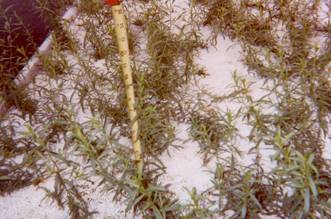French Tarragon as a Commercial Herb Crop-2004 Report
go.ncsu.edu/readext?441657
en Español / em Português
El inglés es el idioma de control de esta página. En la medida en que haya algún conflicto entre la traducción al inglés y la traducción, el inglés prevalece.
Al hacer clic en el enlace de traducción se activa un servicio de traducción gratuito para convertir la página al español. Al igual que con cualquier traducción por Internet, la conversión no es sensible al contexto y puede que no traduzca el texto en su significado original. NC State Extension no garantiza la exactitud del texto traducido. Por favor, tenga en cuenta que algunas aplicaciones y/o servicios pueden no funcionar como se espera cuando se traducen.
Português
Inglês é o idioma de controle desta página. Na medida que haja algum conflito entre o texto original em Inglês e a tradução, o Inglês prevalece.
Ao clicar no link de tradução, um serviço gratuito de tradução será ativado para converter a página para o Português. Como em qualquer tradução pela internet, a conversão não é sensivel ao contexto e pode não ocorrer a tradução para o significado orginal. O serviço de Extensão da Carolina do Norte (NC State Extension) não garante a exatidão do texto traduzido. Por favor, observe que algumas funções ou serviços podem não funcionar como esperado após a tradução.
English
English is the controlling language of this page. To the extent there is any conflict between the English text and the translation, English controls.
Clicking on the translation link activates a free translation service to convert the page to Spanish. As with any Internet translation, the conversion is not context-sensitive and may not translate the text to its original meaning. NC State Extension does not guarantee the accuracy of the translated text. Please note that some applications and/or services may not function as expected when translated.
Collapse ▲This is a 2004 report from a NC Specialty Crops Program Project. It is posted for historical reference purposes.
PROJECT LEADER(S): Willie Wilson for Jerry Walden
LOCATION: Estelle Farms, 4650 White Store Rd., Wingate, NC 28174
IMPACT
Demand for fresh cut culinary herbs is increasing in the southern piedmont region of NC. Initial trials show that French Tarragon can be grown in North Carolina as a commercial culinary herb crop.
INTRODUCTION
Use of fresh cut culinary herbs has been on the increase in the last few years. This trend will continue as people assume healthier eating habits and the number of restaurants that use fresh herbs increases. The use of fresh herbs as compared to dried or processed is continually growing, especially among formally trained chefs. With the recent opening of a major culinary arts university in Charlotte and the growth in the culinary arts programs at the community colleges, demand for fresh herbs is sure to grow. French Tarragon was chosen as it is not normally grown commercially in this region. French Tarragon does not produce viable seed so it must be propagated by division in the spring or fall. Growers should beware as there are a number of varieties that are not suitable for culinary use.
METHODS
Two methods were used for this trial; 1 – Hydroponic using perlite as the growing medium with a continuous flow standard 1200ppm nutrient solution at a pH of 6.3. The crop was grown on 4’x10’ raised tables with 5” plant and row spacing. 2 – This method involved the potting of the plants in a peat lite mix composed of 55% Canadian Sphagnum Peat, perlite, and vermiculite. These plants were place on a 30 day fertilization plan using and all purpose 15-30-15 fertilizer and water as required to maintain the potting mix moist.
RESULTS
The rate of growth was 1/3 faster for the hydroponic method as opposed to the potted plants with the former reaching harvest size in five weeks compared to seven weeks for the latter. The initial harvest from the hydroponic crop yielded 5lbs, per table or 1lb.per 8 square feet of growing space, with a 3 week recovery period to the second harvest. As the plants propagate from the roots, the plant density increases and the per harvest amounts increase i.e. after six months the per harvest amount was 8lbs. per table. The initial harvest for the potted plants yielded 1lb. per 55 plants, with a recovery period of five weeks to next harvest. As these plants propagated the yields increased to 1lb. per 40 plants.
CONCLUSION
French Tarragon can be grown successfully in this region of NC. If grown in a conventional outdoor setting, beds are recommended to maximize plant density and space utilization.
TABLES & PHOTOS
Reviewed by Jeanine Davis, NC Alternative Crops & Organics Program, Department of Horticultural Science, NC State University on 7/22/2022.




